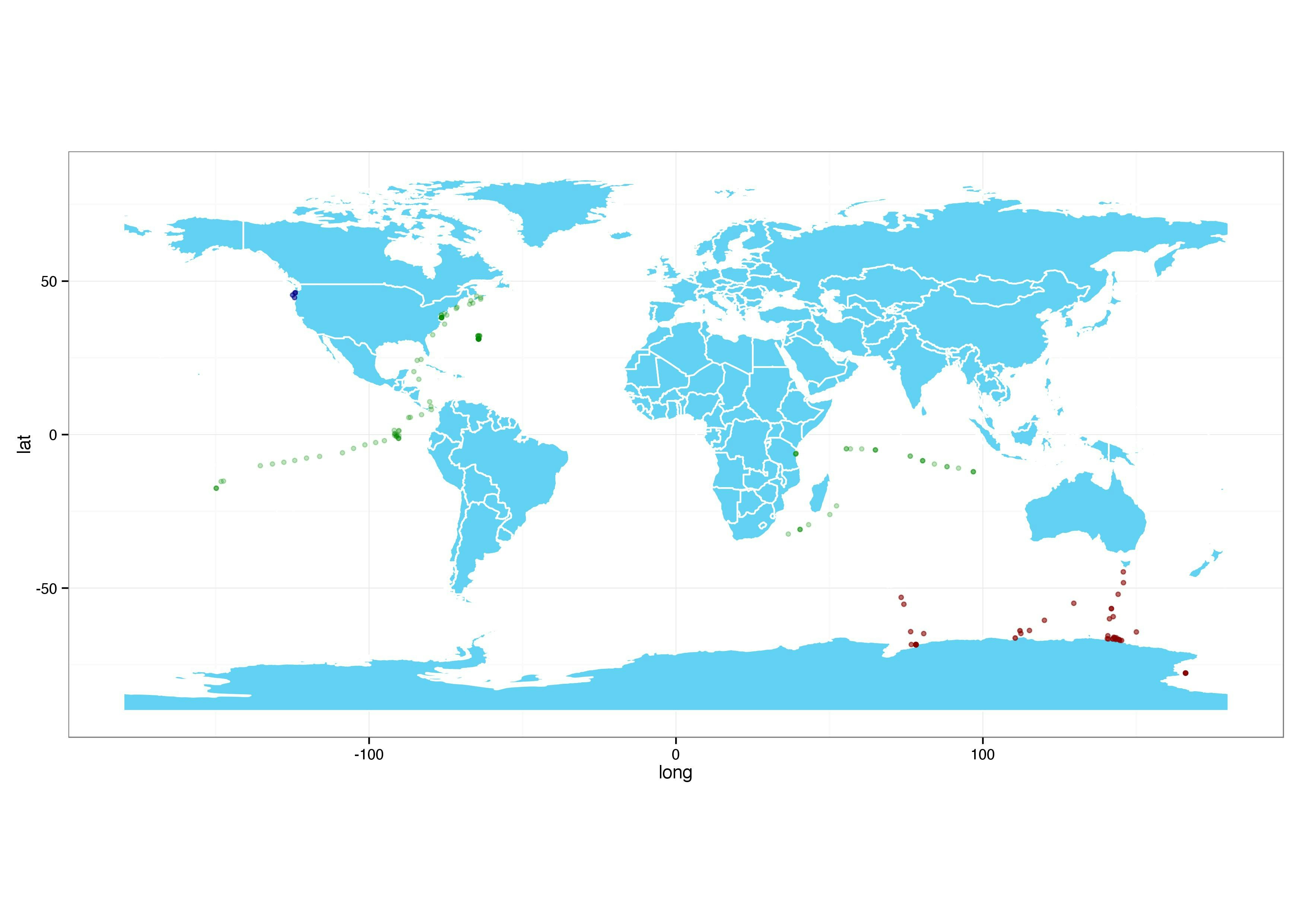概要
あるプロジェクトにおけるサンプルのサンプリングポイントがどこだかを可視化しました.
(ただし,メタデータの全てを得られたわけではないので,ここにあるのが全てというわけではありません)
Rで描く
# install.packages("maptools")
# install.packages("rgeos")
# install.packages("gpclib")
rm(list=ls())
library(maptools)
library(rgeos)
library(ggplot2)
gpclibPermit()
theme_set(theme_bw())
world.shp <- readShapeSpatial("~/Downloads/TM_WORLD_BORDERS-0/TM_WORLD_BORDERS-0.3.shp")
# check for region-id - Use "FIPS"
head(world.shp@data)
## see licence, not GPL
# world.shp.p <- fortify.SpatialPolygonsDataFrame(world.shp, region="FIPS")
world.shp.p <- fortify(world.shp, region="FIPS")
world <- merge(world.shp.p, world.shp, by.x="id", by.y="FIPS")
head(world)
dim(world)
# only the worldmap
p <- ggplot(data=world, aes(x=long, y=lat, group=group)) +
geom_polygon(fill="#63D1F4")
p <- p + geom_path(color="white") + coord_equal()
plot(p)
ggsave(p, width=11.69, height=8.27, file="world_map.jpg")
## Add some locations
d <- read.table("~/Desktop/gcos_point.txt", header=T)
colnames(d) <- c("lat", "long")
dat <- read.table("~/Downloads/CAM_PROJ_GOS.csv", header=T, sep=",")
colnames(dat)[grep("LATITUDE", colnames(dat))] <- "lat"
colnames(dat)[grep("LONGITUDE", colnames(dat))] <- "long"
p1 <- p + geom_point(data = dat, aes(group = NULL), shape=20,
color="#00880040")
ggsave(p1, width=11.69, height=8.27, file="world_map_2.jpg")
dat2 <- read.table("~/Downloads/CAM_PROJ_AntarcticaAquatic.csv", header=T, sep=",")
colnames(dat2)[grep("LATITUDE", colnames(dat2))] <- "lat"
colnames(dat2)[grep("LONGITUDE", colnames(dat2))] <- "long"
p2 <- p1 + geom_point(data = dat2, aes(group = NULL), shape=20,
color="#88000040")
ggsave(p2, width=11.69, height=8.27, file="world_map_3.jpg")
dat3 <- read.table("~/Downloads/CAM_P_0001024.csv", header=T, sep=",")
colnames(dat3)[grep("LATITUDE", colnames(dat3))] <- "lat"
colnames(dat3)[grep("LONGITUDE", colnames(dat3))] <- "long"
p3 <- p2 + geom_point(data = dat3, aes(group = NULL), shape=20,
color="#00008840")
ggsave(p3, width=11.69, height=8.27, file="world_map_4.jpg")
サンプリングポイントが重なっている部分は濃くなっています.
参考
- http://r.789695.n4.nabble.com/Projecting-data-on-a-world-map-using-long-lat-td3081298.html
- http://jeffreybreen.wordpress.com/tag/raster/
- 世界地図のshapeデータ: http://thematicmapping.org/downloads/world_borders.php
- プロジェクトについて: http://www.jcvi.org/cms/research/projects/gos/overview/
- プロジェクトのメタデータ: http://camera.calit2.net
